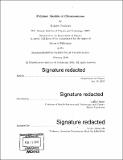Polymer models of chromosomes
Author(s)
Imakaev, Maksim (Maksim Viktorovich)
DownloadFull printable version (39.82Mb)
Other Contributors
Massachusetts Institute of Technology. Department of Physics.
Advisor
Leonid Mirny.
Terms of use
Metadata
Show full item recordAbstract
Studies of chromosomes have a long history. Since late XIX century, microscopy studies have revealed that chromosomal organization as seen by light microscopy is different among organisms, cell types, or stages of the cell cycle. However, the internal organization of chromosomes at scales below the diffraction limit largely remained unexplored. Recently, genomic techniques to measure contacts between genomic regions were developed; the most advanced of them, Hi-C, measures probabilities of contact between all pairs of genomic regions. Throughout my Ph.D, we have been developing methods to analyze Hi-C data, and to infer principles of chromosomal organization from the contact map provided by Hi-C. As a first step, we developed a toolset to map, analyze, and correct the Hi-C data. We then we performed polymer simulations that implement hypothetical principles of chromosomal organization and compared them to the Hi-C data. We showed that mitotic chromosomes in humans are not organized hierarchically, as thought previously, and are likely folded as an array of consecutive chromosomal loops. In the bacterium Caulobacter Crescentus, we showed that the chromosome is organized as a dense array of supercoiled plectonemes interspersed by highly transcribed regions free of plectonemes. Finally, for human interphase chromosomes, we showed that the equilibrium state of a long unknoted polymer chain is inconsistent with the observed properties of chromosomes.
Description
Thesis: Ph. D., Massachusetts Institute of Technology, Department of Physics, 2016. Cataloged from PDF version of thesis. Includes bibliographical references (pages 203-215).
Date issued
2016Department
Massachusetts Institute of Technology. Department of PhysicsPublisher
Massachusetts Institute of Technology
Keywords
Physics.